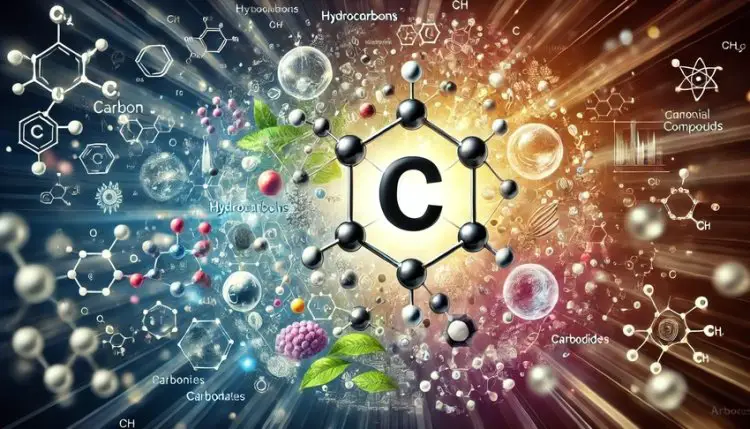Carbon and Its Compounds
Carbon, symbolized by 'C', is a vital element in both organic chemistry and various industrial applications. Its ability to form stable bonds with many elements, including itself, makes it incredibly versatile, creating a vast array of complex molecules. Carbon compounds are categorized into organic compounds, such as hydrocarbons, carbohydrates, proteins, lipids, and nucleic acids, and inorganic compounds like carbonates, carbides, and oxides. These compounds are essential in energy production, medicine, materials science, environmental science, and agriculture. As research advances, the applications of carbon and its compounds continue to grow, offering innovative solutions to global challenges.

Carbon, an element with the symbol 'C' and atomic number 6, is a cornerstone of both organic chemistry and various industrial applications. Its versatility and unique properties make it an essential component in a wide range of compounds and materials. This article delves into the fascinating world of carbon and its compounds, exploring their significance, types, and applications.
The Significance of Carbon
Carbon is the fourth most abundant element in the universe by mass and the second most abundant element in the human body, after oxygen. Its ability to form stable bonds with many elements, including itself, allows it to create a vast array of complex molecules. This versatility is due to carbon's four valence electrons, which enable it to form single, double, and triple bonds.
Carbon Compounds: An Overview
Carbon compounds are broadly classified into two categories: organic and inorganic compounds.
Organic Compounds
Organic compounds are primarily made up of carbon and hydrogen atoms, often with other elements such as oxygen, nitrogen, sulfur, and phosphorus. They form the basis of all known life on Earth.
-
Hydrocarbons: These are the simplest organic compounds, consisting only of carbon and hydrogen. They are divided into:
- Alkanes: Single-bonded hydrocarbons (e.g., methane, ethane).
- Alkenes: Hydrocarbons with one or more double bonds (e.g., ethene, propene).
- Alkynes: Hydrocarbons with one or more triple bonds (e.g., ethyne, propyne).
-
Carbohydrates: Compounds composed of carbon, hydrogen, and oxygen, providing energy for living organisms (e.g., glucose, fructose).
-
Proteins: Complex molecules made up of amino acids, which contain carbon, hydrogen, oxygen, nitrogen, and sometimes sulfur. They play crucial roles in the structure and function of cells.
-
Lipids: Organic compounds that include fats, oils, and waxes. They are made up of carbon, hydrogen, and oxygen and are important for storing energy and forming cell membranes.
-
Nucleic Acids: DNA and RNA, which store and transmit genetic information, are composed of carbon-based nucleotides.
Inorganic Compounds
Inorganic carbon compounds include carbonates, carbides, and oxides. These compounds are essential in various industrial processes and applications.
-
Carbonates: Compounds containing the carbonate ion (CO3^2-). Examples include calcium carbonate (CaCO3), found in limestone, and sodium carbonate (Na2CO3), used in glass manufacturing.
-
Carbides: Compounds composed of carbon and a less electronegative element. Silicon carbide (SiC) is widely used as an abrasive and in cutting tools.
-
Oxides of Carbon: The most common oxides are carbon dioxide (CO2) and carbon monoxide (CO). CO2 is a greenhouse gas, while CO is a toxic gas produced by incomplete combustion.
Applications of Carbon Compounds
Carbon and its compounds have numerous applications across various industries:
-
Energy: Hydrocarbons, such as petroleum and natural gas, are primary energy sources. Coal, composed mainly of carbon, is also a significant energy resource.
-
Medicine: Organic compounds form the basis of many pharmaceuticals. Carbon-based materials like graphene and carbon nanotubes are being explored for medical applications, including drug delivery and tissue engineering.
-
Materials Science: Carbon fibers and composites are used in the aerospace and automotive industries due to their strength and lightweight properties. Diamonds, another form of carbon, are used in cutting tools and jewelry.
-
Environmental Science: Understanding carbon compounds is crucial for addressing climate change. Efforts to reduce CO2 emissions and develop carbon capture technologies are vital for mitigating global warming.
-
Agriculture: Carbon-based fertilizers, such as urea (CO(NH2)2), play a significant role in enhancing crop yields.
Conclusion
Carbon's ability to form a wide variety of compounds makes it indispensable to life and industry. From the simplest hydrocarbons to the most complex biomolecules, carbon compounds are integral to the energy, medicine, materials science, and environmental sectors. As research and technology advance, the potential applications of carbon and its compounds continue to expand, promising new solutions to global challenges.
What's Your Reaction?





















